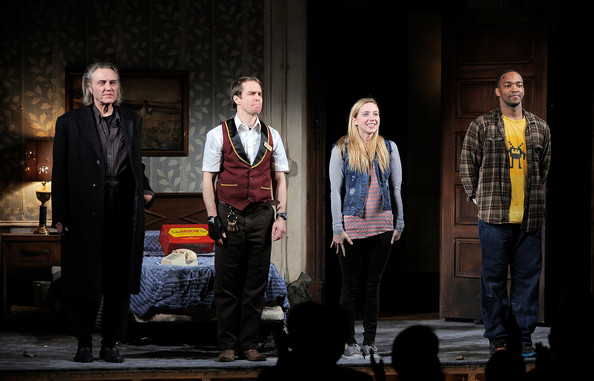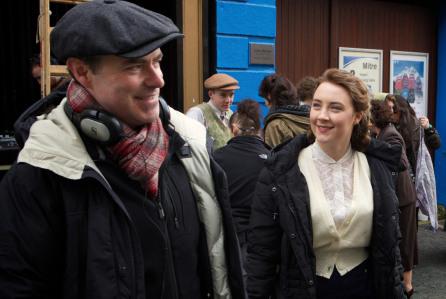Brooklyn is an adaptation of an Irish novel (by Colm Toibin) directed by an Irishman (John Crowley) and starring an Irishwoman (Saoirse Ronan). It is the emotional, but not sentimental story of Eilis (pronounced “AY-lish”) Lacey’s journey to 1950s America, and the resulting sense of displacement she feels when she is called back to Ireland after finally adjusting to life in Brooklyn, New York. It is an absolutely lovely film in so many ways (read my review), landing on countless top 10 lists of the best movies of 2015. It’s also a movie which was difficult to finance, ending up as a British-Canadian-Irish co-production, and while it remains criminally under-seen (a current domestic gross of $22m) it has at least found more of an audience than some of this year’s other awards contenders (e.g., Carol, Room, Youth, Steve Jobs, The Danish Girl, Trumbo, Grandma).
But how did this movie came about? What are some of the behind the stories which help explain the brilliance of the final product?
1) It’s based in historical fact
From the New York Times:
The 1950s was considered one of Ireland’s toughest decades since the famine, and about 15 percent of the country’s population was forced by economic hardship to move abroad.
“Everybody feels they know the emigration story, because they know of the vast numbers that actually left, but it actually hasn’t been done that much, and certainly never from a female perspective,” Mr. Crowley said. “And they’re very sad stories. They tended to be individuals going off on their own, and it was quite a shameful chapter for a while, that Ireland’s biggest exports were the brightest and best of its young people.”
2) It took several years for the schedules to work out for the director and producers
 Brooklyn is director John Crowley’s fifth feature film, but prior to this point he’s been more known for his work in the theater, particularly his collaborations with Martin McDonagh. In 2003, he directed McDonagh’s play Pillowman. They co-wrote the script for the 2008 film In Bruges, and in 2010 they returned to the stage for the black comedy A Behanding in Spokane, McDonagh writing, Crowley directing. That’s the one about Christopher Walken spending 27 years searching for his severed hand. It didn’t go over very well with audiences.
Brooklyn is director John Crowley’s fifth feature film, but prior to this point he’s been more known for his work in the theater, particularly his collaborations with Martin McDonagh. In 2003, he directed McDonagh’s play Pillowman. They co-wrote the script for the 2008 film In Bruges, and in 2010 they returned to the stage for the black comedy A Behanding in Spokane, McDonagh writing, Crowley directing. That’s the one about Christopher Walken spending 27 years searching for his severed hand. It didn’t go over very well with audiences.
However, that’s right around the time that Crowley’s journey with Brooklyn first started, as he told Deadline:
I had read [Colm Toibin’s 2009] book shortly after it was published while I was directing A Behanding In Spokane. Finola Dwyer and Amanda Posey called and asked if I was available. The timing was bad for me and I didn’t hear from them for awhile. Fortunately it came back to me after Nick [Hornby] had done a draft of the script.
3) Saoirse Ronan is lucky that John Crowley couldn’t take the job in 2010
In 2010, when Dwyer and Posey approached Crowley about potentially directing Brooklyn the obvious choice for Eilis was Saoirse Ronan, but she was only 16-years-old at the time, a bit too young to play a woman in her late teens/early twenties emigrating to America. The eventual delay in the film’s development period obviously worked out for the best, as Crowley acknowledged while talking to Deadline, “As soon as [the directing gig]was properly mine, I said that Saoirse, whom I knew from Atonement, was my first choice to play Eilis. The irony is she would have been way to young when they first approached me.”
4) The director & star both understood Eilis’ homesickness all too well
 A year passed between the official casting of Saorise and the start of production. In the time in-between, Ronan moved to London from her Irish home and suffered through the same type of all-encompassing homesickness as Eilis does in the movie. It was a feeling John Crowley could relate to, having grown up in Cork, Ireland and staying there through college. He eventually moved to London, and landed a fourth-month internship in Chicago, his first time in America. As he told Variety:
A year passed between the official casting of Saorise and the start of production. In the time in-between, Ronan moved to London from her Irish home and suffered through the same type of all-encompassing homesickness as Eilis does in the movie. It was a feeling John Crowley could relate to, having grown up in Cork, Ireland and staying there through college. He eventually moved to London, and landed a fourth-month internship in Chicago, his first time in America. As he told Variety:
When I moved to London, I was confused how weird it felt. And when I’d spend time in Ireland with my mates, it was: “Have I made a terrible mistake?” That’s what it feels like to emigrate, to be in exile. It’s the double-ness, when you go away and you come back. I had thought rather naively that you just travel and expand. It never dawned on me that there would be this other thing pulling you back. It made no sense to me until I read the book, years later. Colm took a hard look at the journey from there to here — and his genius stroke was to go from here to back home again. That’s the big leap in this piece of writing and I think Nick Hornby captured that in the script. Which seems to be what a lot of people are responding to.
When Ronan asked him if she’d ever be able to get over her own homesickness, he told her it would but things would never be the same, “You’re not from the country you’re living in, however great that is. When you go home you’re no longer from that place either. And people view you differently, and you view them differently, and it’s all different. And you can’t tell why.”
5) The scenes in Ireland were filmed just 20 minutes from where Ronan grew up
 Brooklyn filmed in London and Montreal, doubling for New York. It also filmed in Enniscorthy, Ireland. Not only is that Colm Toibin’s hometown, it’s also 20 minutes away from where Ronan grew up, County Carlow in southeastern Ireland. Understandably, this turned Brooklyn into the most personal film of Ronan’s young career. Never before had she played a character who was going through exactly the same thing she was in real life, and the proximity to her actual childhood home made it doubly weird. She told the audience at the Savanna Film Fest in October, “To go home in the middle of that process and make a film about home and about homesickness was overwhelming.”
Brooklyn filmed in London and Montreal, doubling for New York. It also filmed in Enniscorthy, Ireland. Not only is that Colm Toibin’s hometown, it’s also 20 minutes away from where Ronan grew up, County Carlow in southeastern Ireland. Understandably, this turned Brooklyn into the most personal film of Ronan’s young career. Never before had she played a character who was going through exactly the same thing she was in real life, and the proximity to her actual childhood home made it doubly weird. She told the audience at the Savanna Film Fest in October, “To go home in the middle of that process and make a film about home and about homesickness was overwhelming.”
In a New York Times profile she admitted that she was so overwhelmed that some times the only way she could deal with it was by slipping away between takes to somewhere she could be alone to close her eyes and rest her her against a wall, not entirely dissimilar to the pose she strikes on the film’s poster. “When work and home collide in such a huge way, you don’t know what to do with it,” she said.
6) Emory took the longest to cast
Saoirse Ronan was the first person they cast, and Domhnall Gleeson as the nice Irishman who makes up the third leg of a love triangle in the film’s final third was the second person they cast. It took them much longer to decide on the crucial role of Tony, the Italian who wins Eilis’ heart in Brooklyn. The role eventually went to The Place Beyond the Pines‘ Emory Cohen, but as Crowley recalled:
There were lots of opinions regarding the need for a “name” and no “name” was right. Authenticity was everything with the film and the danger of getting it wrong was overwhelming. I could never have connected the boy from The Place Beyond The Pines, but he had enormous charm and a degree of delight and equally you could believe he was a plumber — but not in a macho sense. He’s the kind of man who can handle a wrench and have a sweetness about him. I needed an actor who was egoless, who didn’t mind appearing slightly less intelligent than the actress and Emory was happy just to embrace it and just go with it. The producers went along with it, and believe me, this was not an easy film to finance.
7) Colm Toibin requested that they cast as many Irish actors as possible
From the New York Times:
Heeding Mr. Toibin’s request, Mr. Crowley also carefully filled many of the other parts in the film with Irish actors; among them some of the young women in Eilis’s Brooklyn boardinghouse and, perhaps most notably, Brid Brennan, who is basically Ireland’s Meryl Streep, as Nettles Kelly, Eilis’s razor-tongued boss. (Ms. Brennan and Mr. Toibin had, as it happens, briefly been roommates in Dublin in the late ’70s.)
8) Is that Ellis Island?
 In my review, I assumed the above sequence – Eilis getting off the boat and standing in the queu to enter into America – takes place at Ellis Island. That’s definitely where it takes place in the book. However, here’s what Nick Hornby told The Hollywood Reporter last month:
In my review, I assumed the above sequence – Eilis getting off the boat and standing in the queu to enter into America – takes place at Ellis Island. That’s definitely where it takes place in the book. However, here’s what Nick Hornby told The Hollywood Reporter last month:
I trusted Colm Tobin because he’s a great novelist. In fact, I wrote the scene where Eilis enters New York and comes to Ellis Island, and Colm describes all of this beautifully in the novel. I did my own version of that. Then just before filming one of the production team phoned up and said, “Did you know that people stopped coming to New York through Ellis Island in about 1934?” And I said, “No, I did not know that.” So, I phoned up Colm and told him that, and he said, “Hmm, that’s interesting.”

